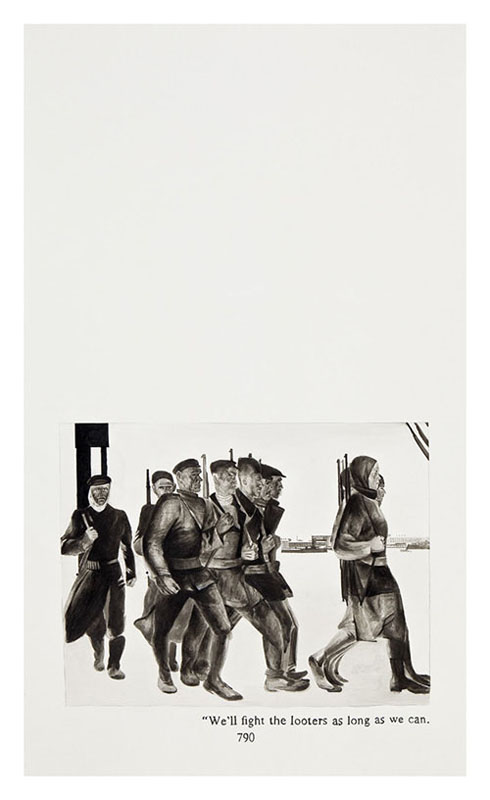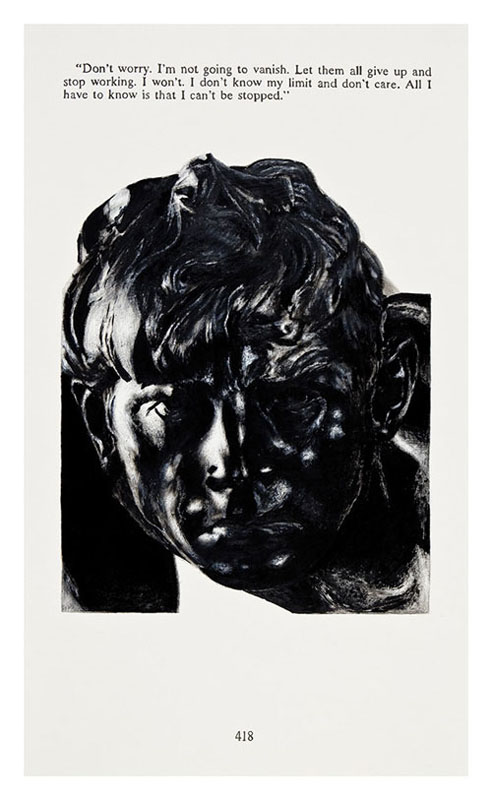Yevgeniy Fiks, Ayn Rand in Illustrations (Exhib. Review)
Yevgeniy Fiks, Ayn Rand in Illustrations, Winkleman Gallery, New York, June 18 – July 30, 2010
 Yevgeniy Fiks’ project Ayn Rand in Illustrations combines two divergent ideological paradigms – Western Objectivism, as it is expressed in Atlas Shrugged (1957), a lengthy novel by American author and philosopher Ayn Rand, and Socialist Realism, an aesthetic dogma formulated in Soviet Russia under Stalin. Both converge on a new hybrid counter-image of modern history. Illustrations consist of a large number of book pages (even with the page numbers), each divided in two sections: a text with a fragment from Rand’s book, and an illustrative image. It is interesting that Fiks, who is an academically trained realist painter educated in Moscow, refuses to create the images for his project himself. Instead he uses those found in old Soviet-era books and magazines, or rather he misuses them by subverting their original purpose of conveying the Communist dream of new masses. Fiks goal is to illustrate Rand’s book’s moral philosophy based on rational self-interest.
Yevgeniy Fiks’ project Ayn Rand in Illustrations combines two divergent ideological paradigms – Western Objectivism, as it is expressed in Atlas Shrugged (1957), a lengthy novel by American author and philosopher Ayn Rand, and Socialist Realism, an aesthetic dogma formulated in Soviet Russia under Stalin. Both converge on a new hybrid counter-image of modern history. Illustrations consist of a large number of book pages (even with the page numbers), each divided in two sections: a text with a fragment from Rand’s book, and an illustrative image. It is interesting that Fiks, who is an academically trained realist painter educated in Moscow, refuses to create the images for his project himself. Instead he uses those found in old Soviet-era books and magazines, or rather he misuses them by subverting their original purpose of conveying the Communist dream of new masses. Fiks goal is to illustrate Rand’s book’s moral philosophy based on rational self-interest.
On the one hand, Fiks’ project deals with what Jacques Rancière has defined as the “ethical regime of images,” which questions where images originate and how they affect individuals and communities, rather than addressing their aesthetic purpose.(Jacques Ranciere, The Politics of Aesthetics. London, New York, 2004. P. 20-21.) In other words, Fiks’ work goes beyond what appears to be a set of illustrations and brings an unexpected complexity to the seemingly simple gesture of juxtaposing pictures with text.
 On the other hand, one might doubt if two things that seem as mutually incompatible as excerpts from Rand’s novel Atlas Shrugged and images from the realm of Socialist Realism can really be combined within the format of one book page so thoroughly that they look as if they originated in the same source. But are the two philosophical and ethical positions really so opposite? Indeed, while they do fetishize the “man of reason” – a charismatic individual, stiff, unbreakable and opposed to the contemptible mob (think: collective) –, the shaky philosophical arguments of Ayn Rand’s books still have a lot in common with the idioms of Soviet culture, including its propaganda and its tendency to idealize and romanticize (the individual versus the collective, and vica versa).
On the other hand, one might doubt if two things that seem as mutually incompatible as excerpts from Rand’s novel Atlas Shrugged and images from the realm of Socialist Realism can really be combined within the format of one book page so thoroughly that they look as if they originated in the same source. But are the two philosophical and ethical positions really so opposite? Indeed, while they do fetishize the “man of reason” – a charismatic individual, stiff, unbreakable and opposed to the contemptible mob (think: collective) –, the shaky philosophical arguments of Ayn Rand’s books still have a lot in common with the idioms of Soviet culture, including its propaganda and its tendency to idealize and romanticize (the individual versus the collective, and vica versa).
Fiks describes the relationships between two polar utopias, Western Objectivism and Socialist Realism, as “symbiotic and interchangeable.” There is nothing new here, for any ideology, be it liberal or repressive, bears similar qualities. Yet where Fiks’ project becomes interesting is at the point where he chooses between these two moral traditions, e.g., egotistical Objectivism and its opposite, namely the “repressive” collectivism of the Soviet model. Both traditions have been worshiped, condemned and repressed in turn, but never completely abandoned – neither in Russia, nor in the United States. What Fiks’ project brings to light is the connection between these two traditions as it manifests itself in contemporary mainstream and as well as avant-garde culture. In the process it shows up the developments inside the US and Soviet Russia.
 Boris Groys has defined Socialist Realism as a utopian mass culture “that had yet to be created.”(Boris Groys, Total Art of Stalinism: Avant-Garde, Aesthetic Dictatorship and Beyond.) Western culture, by contrast, drew a line between avant-garde and mass taste (modernism versus kitsch, as in Greenberg’s understanding), and this echoes in Rand’s characters who always feel like outsiders in a world they believe is dominated by mediocrity, the collective, “the mob.” Western mass culture, according to Groys, is driven by the assumption that an unalterable human being is both its reason and purpose.(Boris Groys, Total Art of Stalinism: Avant-Garde, Aesthetic Dictatorship and Beyond.) The strong individuals of Rand’s books (who reflect mainstream thinking, given the popularity of her Objectivist literature and philosophy in the US during the 1940s and ‘50s) do not undergo change; rather the world adjusts to their principles (like those expressed by the architect Howard Roark in “The Fountainhead:” “I don’t receive, or give help to anybody;” “I don’t acknowledge any standards, but I impose my own ones,” etc.). By contrast, Soviet culture depicts strong, monumental characters that evolve directly out of the masses, epitomizing their desire to dominate the world.
Boris Groys has defined Socialist Realism as a utopian mass culture “that had yet to be created.”(Boris Groys, Total Art of Stalinism: Avant-Garde, Aesthetic Dictatorship and Beyond.) Western culture, by contrast, drew a line between avant-garde and mass taste (modernism versus kitsch, as in Greenberg’s understanding), and this echoes in Rand’s characters who always feel like outsiders in a world they believe is dominated by mediocrity, the collective, “the mob.” Western mass culture, according to Groys, is driven by the assumption that an unalterable human being is both its reason and purpose.(Boris Groys, Total Art of Stalinism: Avant-Garde, Aesthetic Dictatorship and Beyond.) The strong individuals of Rand’s books (who reflect mainstream thinking, given the popularity of her Objectivist literature and philosophy in the US during the 1940s and ‘50s) do not undergo change; rather the world adjusts to their principles (like those expressed by the architect Howard Roark in “The Fountainhead:” “I don’t receive, or give help to anybody;” “I don’t acknowledge any standards, but I impose my own ones,” etc.). By contrast, Soviet culture depicts strong, monumental characters that evolve directly out of the masses, epitomizing their desire to dominate the world.
 Groys has argued that “the Russian avant-garde dream was to harness aesthetic dictatorship of the modernist tradition and abolish the dictatorship of the market.”(Boris Groys, Total Art of Stalinism: Avant-Garde, Aesthetic Dictatorship and Beyond.) In Ayn Rand’s philosophy, on the contrary, the ultimate goal is to create a free economy. The unimpeded movement towards financial fortune is the virtue, and the creative energy of the individual culminates in a dollar sign. In one of Fiks’ altered Illustrations, the quotation from Atlas Shrugged reads: “Galt raised his hand and over the desolate earth he traced in the space the sign of the dollar.” The image added by Fiks is that of a Soviet bronze statue, which possibly represents a Soviet commissar with his arm stretched out towards the future. As a sign of the aberrations of the post-modern, post-Communist, post-capitalist, post-utopian mind, the figure of “free marketer” turns into a rigorous Communist who with similar pathos imposes his rigid “aesthetic order” (Groys) on the world.
Groys has argued that “the Russian avant-garde dream was to harness aesthetic dictatorship of the modernist tradition and abolish the dictatorship of the market.”(Boris Groys, Total Art of Stalinism: Avant-Garde, Aesthetic Dictatorship and Beyond.) In Ayn Rand’s philosophy, on the contrary, the ultimate goal is to create a free economy. The unimpeded movement towards financial fortune is the virtue, and the creative energy of the individual culminates in a dollar sign. In one of Fiks’ altered Illustrations, the quotation from Atlas Shrugged reads: “Galt raised his hand and over the desolate earth he traced in the space the sign of the dollar.” The image added by Fiks is that of a Soviet bronze statue, which possibly represents a Soviet commissar with his arm stretched out towards the future. As a sign of the aberrations of the post-modern, post-Communist, post-capitalist, post-utopian mind, the figure of “free marketer” turns into a rigorous Communist who with similar pathos imposes his rigid “aesthetic order” (Groys) on the world.
Fiks’ project proves that the artwork is not made political but rather becomes political within the context in which it is exhibited. This postmodern hybridization of history through composite images illuminates many things we face in our current politics: it’s not a question of who is in power – creative individuals (think: neo-liberal corporate managers) or “dreaming collectives” empowered by the Stalinist (think: Putinist) bureaucracy –, it’s a question of why we still have ideologies that divide humanity and why the types of collectivity we know, whether they originate inside the liberal capitalist state or in Communist ideals, always end up in death camps. Lastly, it’s a question of why modernism was so flawed and why postmodernism provides us with a mirror that unequivocally reflects our own madness.
See also “Yevgeniy Fiks at Winkleman Gallery (Exhib. Review)” by Yulia Tikhonova.



